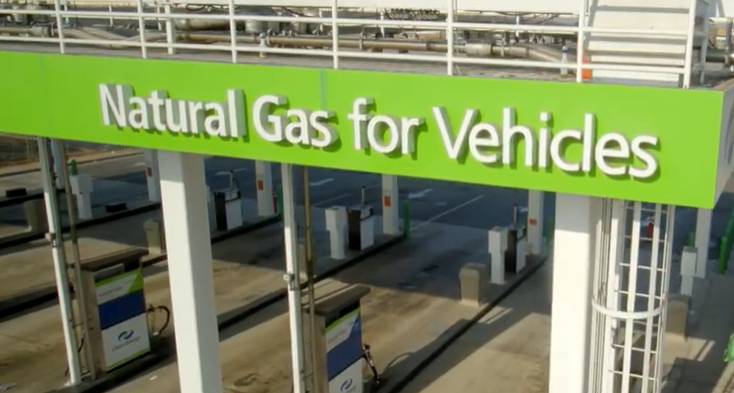Increased Fleet Investment in Near-Zero Emission Natural Gas Trucks Providing Cost-Effective Clean Air Solutions Now
There is measurable, impactful, and consistent progress being made with today’s technology and fuel
The California Natural Gas Vehicle Partnership (CNGVP) says that real-world fleets are increasingly turning to near-zero emissions (NZE) natural gas vehicles (NGVs) and carbon-negative renewable natural gas (RNG) to make true sustainability progress. NZE NGVs are available now delivering critical and cost-effective emissions reductions throughout California, where heavy-duty diesel trucks are the state’s largest single combined source of smog-forming NOx (oxides of nitrogen) and toxic diesel particulate matter (DPM), and one of the largest, and growing sources of climate-altering greenhouse gases (GHG) emissions.
“Today, fleets across California and the nation are investing in commercially available and proven natural gas vehicles, choosing sustainable technology that meets their wide ranging and intensive operational needs while keeping an eye on future opportunities to incorporate electric trucks when they are available and make sense from a cost and performance perspective,” said Ashley Remillard, Vice President of Legal and Government Affairs at Hexagon Agility, and Vice Chair of the California Natural Gas Vehicle Partnership.
One example, highlighted during the press conference, is Matheson Postal Services, a subsidiary of Matheson Trucking Inc., which has moved mail coast-to-coast for the U.S. Postal Service since 1964. Matheson operates 95 NZE trucks on its contracted mail routes, hauling 78,000-pound loads through diverse terrains, running more than 16.4 million miles annually. Each of Matheson’s heavy-duty NZE natural gas big rigs runs an average of 185,000 miles per year, or 715 miles per day, which provides significant reductions of diesel use, DPM and GHG emissions. Because of its positive economic and environmental results, Matheson announced that it has placed an order for another 40 NZE CNG trucks, including Kenworth’s CNG-fueled T680 tractors and CNG T680 sleeper-cab tractors, featuring Hexagon Agility’s ProCab® 175 and dual ProRail® 40 fuel systems, which provide over 265 diesel gallon equivalent of CNG and well over 1,000 mile range. These trucks are scheduled to be delivered in late 2021 and early 2022.
“Matheson has continued making investments in NZE NGVs because they are reliable and provide the power, range and performance we need to perform under the rigorous demands of long-haul trucking, pulling heavy loads under challenging conditions and terrains, all while reducing our carbon footprint,” said Mark Matheson, president and CEO of Matheson Trucking, Inc. “No other technology commercially available today, or even promised for tomorrow, can deliver the environmental results we are achieving while also meeting our operational requirements.”
“There is measurable, impactful, and consistent progress being made with today’s technology and fuel. NZE NGVs are the closest direct replacement for diesel trucks in terms of their ability to quickly refuel via an established network of infrastructure, and in terms of their power and range for both regional and long-haul routes. Most importantly, NGVs enable fleets to compete on a cost-per-mile basis with diesel engines,” said Tom Swenson, business development manager at Cummins and Chair of the California Natural Gas Vehicle Partnership.
Investment in NZE NGVs is even more effective as fleets utilize carbon negative RNG. In Q1 2021, data from the California Air Resources Board’s (CARB) Low Carbon Fuel Standard (LCFS) program revealed that the average annual carbon intensity of compressed natural gas from renewable feedstocks (“bio-CNG”) was -16.57gCO2e/MJ, the lowest average of any currently available vehicle fuel—including renewable electricity. This means that fleet vehicles fueled by RNG in California are helping to remove more greenhouse gas emissions from the atmosphere than any other alternative fuel available, and ultimately help to eliminate the climate impact of these heavy-duty vehicles.
Wayne Nastri, South Coast Air Quality Management District (AQMD) executive officer, recently noted in a public letter, “While the amount of emission reductions needed to attain clean air standards is daunting, it would be irresponsible for our agency to effectively throw up our hands and not explore all options for reducing emissions now. NZE technology has been commercially demonstrated and is available today, has sufficient fueling infrastructure that is largely funded by the private sector, and is at least 90% cleaner than new diesel trucks on NOx and 100% cleaner on cancer-causing diesel particulate matter. When fueled by renewable natural gas, these vehicles are far more cost-effective than ZE trucks, allowing limited incentive funds to stretch further.”
The California Natural Gas Vehicle Partnership (CNGVP) is an alliance of air quality, transportation and energy agencies, vehicle and engine manufacturers, fuel providers, transit and refuse hauler associations, and other stakeholders interested in increasing and strengthening the deployment of low-emission natural gas vehicles throughout California.
Category: Engines & Drivetrains, Equipment, Featured, Fuel & Oil, General Update, Green, News, Tech Talk, Vehicle Lifts, Vehicles











